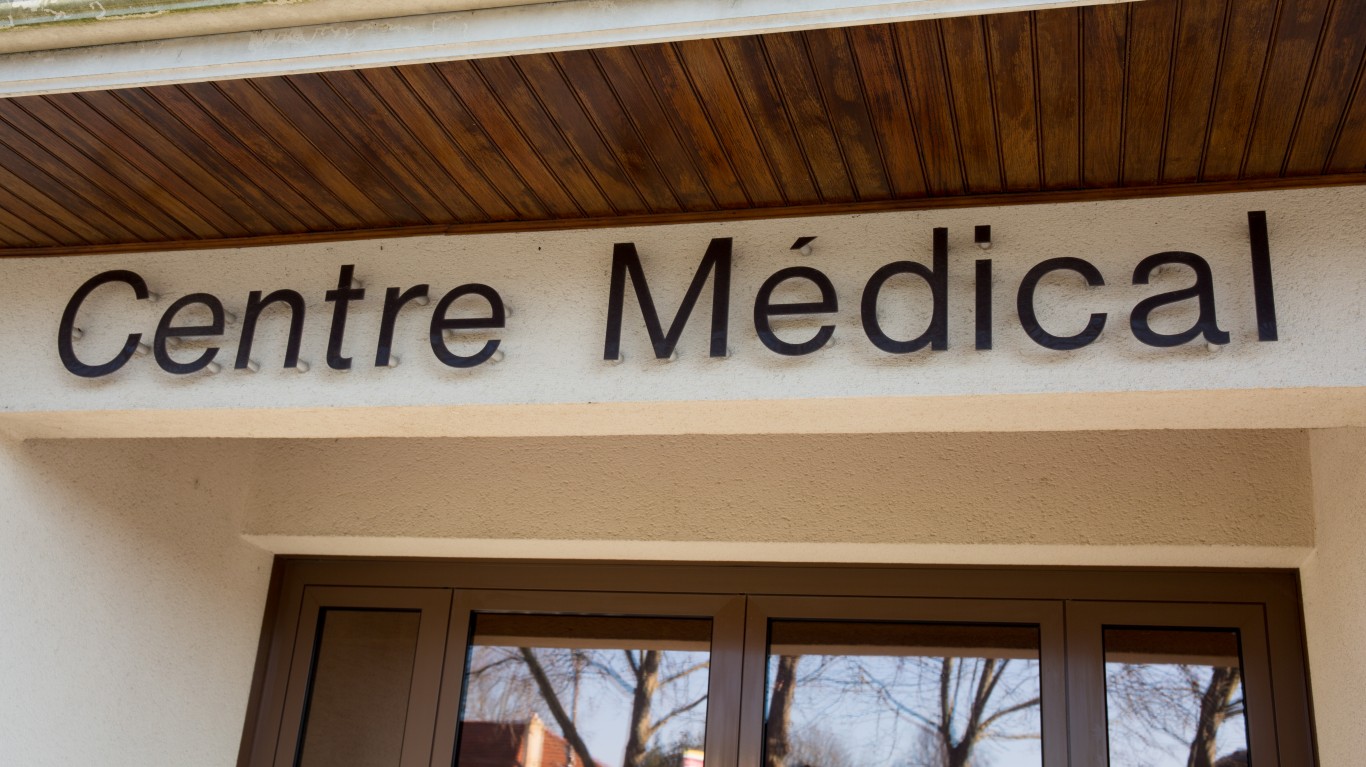Special Report
Countries That Spend the Most on Public Health

Published:
Last Updated:

Has the thought of cost ever prevented you from going to the doctor? The issue of health care costs is not just an individual concern but a national and global one as well. In fact, health care costs are growing faster than the rest of the global economy, according to the World Health Care Organization (WHO).
Every country has its unique political, economic, and social climate affecting its health care policies and spending. 24/7 Tempo reviewed health care expenditure data from the Organization for Economic Co-operation and Development (OECD), a group of 34 predominantly rich countries, because health spending is associated with a nation’s wealth.
A third of OECD countries spend more than $2,000 per person each year on health care. The 12 countries with the highest health care costs, spend about twice that amount. The differences between countries is staggering, ranging from more than $8,000 per person in the country with the most expensive health care system to $541 in the OECD country with the lowest health care expenses per capita.
The countries spending the most on health care today allocate between 3% and 14% of their total gross domestic product (GDP) on health care costs. The average amount spent on health care per person in comparable countries is $3,018. This is less than half the U.S. figure of $8,047 per person per year (and this is what every state spends on health care).
Countries’ health expenditures include paying for general medicine, diagnostic procedures such as MRI scans, hospitalizations and surgeries, as well as medications and prescribed treatment. In the United States, for example, what particularly drives up the cost of health care are drug prices, increase in population size, and aging population.
Click here to see the 18 countries that spend the most on health care.
To identify the countries that spend the most on public health, 24/7 Tempo reviewed health care expenditures data from the Organization for Economic Co-operation and Development (OECD), a group of 34 mostly wealthy nations. Expenditure figures are as for 2017, the latest year for which data is available. The countries that spent more than $3,000 per person on public health in 2017 were selected. Additional information on countries’ health care systems was taken from the respective nation’s government sources and the Commonwealth Fund. The annual amount spent on public health as a share of a country’s GDP and number of doctors per capita also came from the OECD.

18. Finland
> Money spent on public health a year: $3,078 per capita
> Share of GDP spent on public health: 7.3%
> Primary care and specialist doctors: 3.2 per 1,000 people (in 2014)
> Life expectancy at birth: 81.8 years
> Population: 5,511,303
The Global Burden of Disease, a research program recently ranked Finland’s health care system best in the world, out of 188 countries. The country’s health care system is publicly financed and emphasizes primary and preventive care. Free health insurance is available for Finish residents and those who study there.
[in-text-ad]

17. Australia
> Money spent on public health: $3,109 per capita
> Share of GDP spent on public health: 6.4%
> Primary care and specialist doctors: 3.6 per 1,000 people (in 2016)
> Life expectancy at birth: 82.5 years
> Population: 24,598,933
Funding the health care system in Australia is a shared responsibility of both the federal and the territories’ governments. The country’s Medicare program, which the Department of Health manages, is a universal health insurance scheme. All Australian residents, and even some overseas visitors, have free — or very cheap — access to many services, including dental for children in certain cases, and eye care and diagnostic tests.

16. United Kingdom
> Money spent on public health: $3,341 per capita
> Share of GDP spent on public health: 7.8%
> Primary care and specialist doctors: 2.8 per 1,000 people (in 2017)
> Life expectancy at birth: 81.0 years
> Population: 66,022,273
The National Health Service (NHS) is the publicly funded national health care system for the U.K., but it has disclosed it has been in crisis mode for years, overburdened and struggling with funds and staff shortages. The NHS is universal and it guarantees care for all residents, even if they do not hold U.K. citizenship or have not paid all of their taxes.

15. Canada
> Money spent on public health: $3,382 per capita
> Share of GDP spent on public health: 7.4%
> Primary care and specialist doctors: 2.7 per 1,000 people (in 2017)
> Life expectancy at birth: 82.3 years
> Population: 36,708,083
Canada provides universal health care for all citizens and permanent residents. The system is publicly funded. In order for provinces and territories to get health-related financial support from the federal government, according to the Canada Health Act, they must provide reasonable access to health services.
[in-text-ad-2]

14. Iceland
> Money spent on public health: $3,758 per capita
> Share of GDP spent on public health: 7.0%
> Primary care and specialist doctors: 3.9 per 1,000 people (in 2017)
> Life expectancy at birth: 82.5 years
> Population: 341,284
Health insurance in Iceland is universal and guaranteed to all citizens and legal residents. There is no private health care sector. Hospitalizations, emergency and general care, dental coverage, maternity and sick leave — are totally or mostly free and paid for through taxes. About 75% of the cost of medication to treat serious illnesses is reimbursed, but the patient pays for antibiotics and painkillers.

13. Belgium
> Money spent on public health: $3,761 per capita
> Share of GDP spent on public health: 8.1%
> Primary care and specialist doctors: 3.1 per 1,000 people (in 2016)
> Life expectancy at birth: 81.0 years
> Population: 11,372,068
The health care system in Belgium is divided into two sectors — federal and regional. Residents who live and work in the country, and have state or private health insurance, are entitled to reimbursement for medical services they receive. The federal government finances hospitals and pays treatments covered by the compulsory health insurance, while regional governments pay for services, including maternity, child, and some elderly care.
[in-text-ad]

12. Ireland
> Money spent on public health: $3,955 per capita
> Share of GDP spent on public health: 6.8%
> Primary care and specialist doctors: 3.1 per 1,000 people (in 2017)
> Life expectancy at birth: 81.6 years
> Population: 4,813,608
The Irish health care system is public, comprehensive, and government-funded, and it is available to everyone who has legally resided in the country for at least a year. Those who have worked and lived in Ireland for a shorter period of time can receive care — free or at a reduced cost — if they prove they intend to remain in the country for at least 12 months.

11. Japan
> Money spent on public health: $3,971 per capita
> Share of GDP spent on public health: 9.1%
> Primary care and specialist doctors: 2.4 per 1,000 people (in 2016)
> Life expectancy at birth: 84.0 years
> Population: 126,785,797
Health care in Japan is universal. Citizens, expats, and even foreigners who have been in the country for over a year pay nothing to receive medical care. The health insurance tax is based on income.

10. Austria
> Money spent on public health: $4,044 per capita
> Share of GDP spent on public health: 7.7%
> Primary care and specialist doctors: 5.1 per 1,000 people (in 2016)
> Life expectancy at birth: 80.9 years
> Population: 8,809,212
Health coverage in Austria is universal. The public health insurance guarantees equal access. The country has several coverage schemes that combined provide coverage for about 99% of residents. Everyone with gainful employment is automatically covered. People who are self employed can also request insurance.
[in-text-ad-2]

9. France
> Money spent on public health: $4,068 per capita
> Share of GDP spent on public health: 9.6%
> Primary care and specialist doctors: 3.4 per 1,000 people (in 2017)
> Life expectancy at birth: 82.3 years
> Population: 67,118,648
Health coverage in France is universal and compulsory, and the health care system is publicly financed. About half of the statutory health insurance is financed by payroll taxes, 35% by income tax, and the rest by taxes on tobacco and alcohol and the pharmaceutical industry, as well as by state subsidies, and voluntary health insurance companies.

8. Denmark
> Money spent on public health: $4,363 per capita
> Share of GDP spent on public health: 8.7%
> Primary care and specialist doctors: 3.7 per 1,000 people (in 2015)
> Life expectancy at birth: 80.7 years
> Population: 5,769,603
Denmark’s health care system, financed through an income tax of 8%, provides universal access to citizens and legal residents. Even though undocumented immigrants and visitors are not covered, there is a voluntary, privately funded initiative from Danish doctors and supported by the Danish Red Cross and Danish Refugee Aid that gives them access to medical care.
[in-text-ad]

7. Netherlands
> Money spent on public health: $4,378 per capita
> Share of GDP spent on public health: 8.8%
> Primary care and specialist doctors: 0.0 per 1,000 people (in 0)
> Life expectancy at birth: 81.5 years
> Population: 17,132,854
Netherlands has a comprehensive health insurance system with universal coverage that is financed by subsidies from taxes and reallocation of payroll levies among health insurers. Residents have the option of paying for private health insurance to complement statutory coverage. About 84% of the population buys complementary insurance that covers dental and eye care, alternative medicine, physiotherapy, and contraceptives.

6. Sweden
> Money spent on public health: $4,606 per capita
> Share of GDP spent on public health: 9.3%
> Primary care and specialist doctors: 4.3 per 1,000 people (in 2015)
> Life expectancy at birth: 82.2 years
> Population: 10,067,744
The health care system in Sweden is universal. Children and young adults up to 19 years of age do not pay for dental services. Most treatment are covered for adults. People can choose any health care provider — private or public (such as municipalities) — they want; referral may be necessary if a patient chooses a provider outside his or her county council.

5. Germany
> Money spent on public health: $4,869 per capita
> Share of GDP spent on public health: 9.6%
> Primary care and specialist doctors: 4.2 per 1,000 people (in 2016)
> Life expectancy at birth: 80.6 years
> Population: 82,695,000
All German citizens and lawful residents have to pay for health insurance at a rate of 14.6% of gross wages. Coverage is universal for all legal residents. People who earn more than $71,564 a year can choose to remain publicly financed — as 75% of them do — or purchase private coverage instead. Those who earn less are mandatorily covered by the national health system.
[in-text-ad-2]

4. Switzerland
> Money spent on public health: $5,030 per capita
> Share of GDP spent on public health: 7.7%
> Primary care and specialist doctors: 4.3 per 1,000 people (in 2016)
> Life expectancy at birth: 82.9 years
> Population: 8,466,017
All Swiss residents pay for health insurance through taxes, funding the entire universal health care system. The insurance covers the costs of medical treatment and hospitalization, but the patient is responsible for part of the cost. Insurance providers are not allowed to profit from the basic package they offer, but they can charge different amounts for supplemental plans.

3. Norway
> Money spent on public health: $5,399 per capita
> Share of GDP spent on public health: 8.9%
> Primary care and specialist doctors: 4.7 per 1,000 people (in 2017)
> Life expectancy at birth: 82.5 years
> Population: 5,282,223
Health care in Norway is universal and automatic to all legal residents and citizens and is publicly financed through numerous taxes. Even though the country is not part of the EU, EU citizens in Norway have the same access to medical services as they would in their own country. Undocumented immigrant only have access to emergency care, but their children have the same access as citizens.
[in-text-ad]

2. Luxembourg
> Money spent on public health: $5,506 per capita
> Share of GDP spent on public health: 5.3%
> Primary care and specialist doctors: 3.0 per 1,000 people (in 2017)
> Life expectancy at birth: 82.3 years
> Population: 599,449
Luxembourg’s health care system is state funded. All citizens and registered long-term residents are entitled to free and subsidised care. The system, financed by people’s income taxes, covers the majority of treatments provided by primary care physicians and specialists, as well as tests that may be needed, medications, and hospitalizations. Patients initially pay part of the cost but are later reimbursed.

1. United States
> Money spent on public health: $8,047 per capita
> Share of GDP spent on public health: 14.0%
> Primary care and specialist doctors: 2.6 per 1,000 people (in 2016)
> Life expectancy at birth: 78.7 years
> Population: 325,719,178
In the United States, the responsibility to provide medical care falls on the government, employers, and individuals. Public health insurance is available to the elderly and people with disabilities (Medicare) and low income residents (Medicaid). The rest of the population can buy private insurance, which is primarily regulated on the state level, through their employers. Self-employed and unemployed individuals have to buy health insurance as well. Should they choose not to, they would pay a fine. As of 2017, nearly 9% of the U.S. population did not have health insurance of any kind.
If you’re one of the over 4 Million Americans set to retire this year, you may want to pay attention. Many people have worked their whole lives preparing to retire without ever knowing the answer to the most important question: am I ahead, or behind on my goals?
Don’t make the same mistake. It’s an easy question to answer. A quick conversation with a financial advisor can help you unpack your savings, spending, and goals for your money. With Zoe Financial’s free matching tool, you can connect with trusted financial advisors in minutes.
Why wait? Click here to get started today!
Thank you for reading! Have some feedback for us?
Contact the 24/7 Wall St. editorial team.